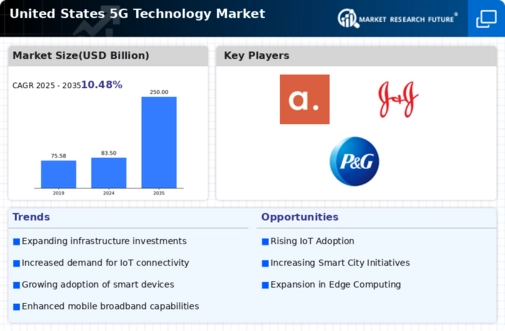Surge in Mobile Device Usage
The proliferation of mobile devices is a significant factor driving the 5g technology market. With an estimated 300 million smartphone users in the US, the demand for faster and more reliable mobile internet is at an all-time high. Consumers are increasingly utilizing mobile applications for various purposes, including e-commerce, social media, and entertainment. This trend is likely to continue, as mobile device penetration is projected to reach 90% by 2026. Consequently, telecom providers are investing heavily in 5g technology to accommodate the growing user base and enhance the overall mobile experience, thereby stimulating market growth.
Growth of Smart Cities Initiatives
The development of smart cities is a pivotal driver for the 5g technology market, as municipalities across the US are increasingly adopting advanced technologies to improve urban living. 5g technology plays a crucial role in enabling smart infrastructure, such as connected traffic systems, energy-efficient buildings, and enhanced public safety measures. The market for smart city solutions is projected to reach $1 trillion by 2025, with 5g technology serving as the backbone for these innovations. As cities strive to enhance sustainability and efficiency, the integration of 5g technology is expected to accelerate, fostering a more connected urban environment.
Advancements in Autonomous Technologies
The rise of autonomous technologies, including self-driving vehicles and drones, is poised to significantly impact the 5g technology market. These technologies require ultra-reliable low-latency communication, which 5g networks can provide. As the automotive industry invests billions in research and development for autonomous vehicles, the demand for 5g technology is expected to increase correspondingly. The market for autonomous vehicles is projected to reach $557 billion by 2026, with 5g technology being a critical enabler for safe and efficient operation. This intersection of automotive innovation and telecommunications is likely to drive substantial growth in the 5g technology market.
Rising Demand for High-Speed Connectivity
The 5g technology market is experiencing a surge in demand for high-speed connectivity, driven by the increasing reliance on digital services across various sectors. Businesses and consumers alike are seeking faster internet speeds to support activities such as streaming, online gaming, and remote work. According to recent data, the average download speed in the US has increased significantly, with 5g technology expected to provide speeds up to 100 times faster than 4g. This demand for enhanced connectivity is likely to propel investments in 5g infrastructure, as companies aim to meet consumer expectations and remain competitive in a rapidly evolving digital landscape.
Increased Focus on Cybersecurity Solutions
As the 5g technology market expands, the need for robust cybersecurity solutions becomes increasingly critical. The interconnected nature of 5g networks raises concerns about data privacy and security vulnerabilities. In response, businesses and government agencies are prioritizing investments in cybersecurity measures to protect sensitive information and maintain consumer trust. The cybersecurity market is expected to grow to $345 billion by 2026, with a significant portion of this growth attributed to the demands of 5g technology. This heightened focus on security is likely to drive innovation and investment in cybersecurity solutions tailored for the unique challenges posed by 5g networks.

















Leave a Comment